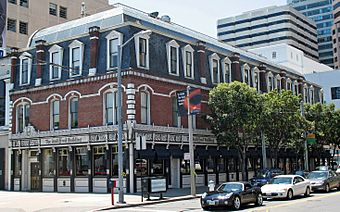Audiffred Building facts for kids
Quick facts for kids |
|
|
Audiffred Building
|
|
 |
|
| Location | 100 The Embarcadero / 1–21 Mission St., San Francisco, California, US |
|---|---|
| Area | 0.1 acres (0.040 ha) |
| Built | 1889 |
| Architect | Hippolite d'Audiffret; William Cullen |
| Architectural style | Second Empire |
| NRHP reference No. | 79000528 |
| Added to NRHP | May 10, 1979 |
The Audiffred Building is a historic three-story building in San Francisco, California, United States. It used to be home to waterfront businesses and a union for sailors. Today, it houses the Boulevard restaurant.
This building is very important to San Francisco's history. It is officially recognized as City of San Francisco Landmark number 7. It was also added to the National Register of Historic Places in 1979. This means it's a special place worth protecting.
Contents
Where is the Audiffred Building?
The Audiffred Building is located right on the corner of Mission Street and the Embarcadero. It faces the beautiful San Francisco waterfront. It's one of the few old buildings left on the land side of the Embarcadero.
For many years, a big elevated highway, the Embarcadero Freeway, blocked its view. But after the 1989 Loma Prieta earthquake, the freeway was removed. Now, the Audiffred Building once again has a clear view of the bay.
What Does the Audiffred Building Look Like?
This building is made of brick. It has special brick designs called "quoins" on the corners of the second floor. Its style is called Second Empire, which was popular in French commercial buildings in the late 1800s.
The building has three floors. The top floor is tucked inside a unique tiled mansard roof that has a cool diamond pattern. On the first floor, you can see fancy cast iron columns. These columns have flower designs and the letter "A" on them.
Above the first floor, on the front of the building, there's a detailed carving. It shows things related to the sea, like dolphins, lighthouses, sailing ships, and seahorses.
A Look Back in Time: History of the Building
The Audiffred Building was built in 1889 for a man named Hippolite d'Audiffret. He was from France and had a successful business selling charcoal in Chinatown.
When it first opened, the ground floor had a restaurant and three taverns (like pubs). One of these was The Bulkhead tavern. The upper floors were used by different unions for sailors and marine workers. For example, the Coast Seamen's Union had offices there.
Surviving the 1906 Earthquake
In 1906, a huge earthquake hit San Francisco, followed by terrible fires. The San Francisco Fire Department almost destroyed the Audiffred Building to stop the fires from spreading. Luckily, the building was saved.
A Place for Workers' Rights
The Audiffred Building played an important role in workers' history. It was a meeting place during big strikes. For example, it was the headquarters for the 1901 San Francisco City Front strike and the 1934 San Francisco waterfront strike.
During the 1934 strike, two sailors, Howard Sperry and Nick Bordoise, lost their lives outside the building. A monument across the street now remembers them.
Bank and Artists
In 1928, one of the first branches of the Bank of Italy moved into the building. This bank later became Bank of America. The nautical carvings on the building were actually made for the bank!
Later, as San Francisco's waterfront changed, the building became home to different groups. In 1946, the Seven Seas Club for sailors moved in. Also, many artists and writers, like Elmer Bischoff and Lawrence Ferlinghetti, used the upper floors as studios.
Saved from Demolition
In 1978, a fire badly damaged the building. It was almost torn down. But people wanted to save it because of its history. So, it was placed on the National Register of Historic Places in 1979. It had already been named a San Francisco City Landmark in 1968.
After the fire, the building was repaired and updated. A new domed section was added to the top. Since 1993, the Audiffred Building has been home to the popular Boulevard restaurant.



